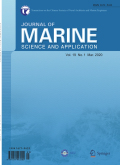- 钛学术文献服务平台 \
- 学术期刊 \
- 工业技术期刊 \
- 大学学报期刊 \
- 船舶与海洋工程学报(英文版)期刊 \
Blast Pressure Measurements of an Underwater Detonation in the Sea
Blast Pressure Measurements of an Underwater Detonation in the Sea
基本信息来源于合作网站,原文需代理用户跳转至来源网站获取
摘要:
Blast pressure measurements of a controlled underwater explosion in the sea were carried out. An explosive of 25-kg trinitro-toluene (TNT) equivalent was detonated, and the blast pressures were recorded by eight different high-performance pressure sensors that work at the nonresonant high-voltage output in adverse underwater conditions. Recorded peak pressure values are used to establish a relationship in the well-known form of empirical underwater explosion (UNDEX) loading formula. Constants of the formula are redetermined by employing the least-squares method in two different forms for best fitting to the measured data. The newly determined constants are found to be only slightly different from the generally accepted ones.

推荐文章
Bottom water temperature measurements in the South China Sea,eastern Indian Ocean and western Pacific
海底底水温度(BWT)
南海(SCS)
东印度洋(EIO)
西太平洋(WPO)
大洋传送带模式
Thermodynamic properties of San Carlos olivine at high temperature and high pressure
San Carlos olivine
Thermodynamic property
Thermal expansion
Heat capacity
Temperature gradient
机械臂柔性关节SEA设计与仿真分析
机械臂
柔性关节
串联弹性驱动器
弹性曲梁
基于SEA的系统动态效能评价
C3I
动态评价
系统效能
内容分析
关键词云
关键词热度
相关文献总数
(/次)
(/年)
文献信息
| 篇名 | Blast Pressure Measurements of an Underwater Detonation in the Sea | ||
| 来源期刊 | 船舶与海洋工程学报(英文版) | 学科 | |
| 关键词 | |||
| 年,卷(期) | 2021,(4) | 所属期刊栏目 | |
| 研究方向 | 页码范围 | 706-713 | |
| 页数 | 8页 | 分类号 | |
| 字数 | 语种 | 英文 | |
| DOI | |||
五维指标
引文网络
引文网络
二级参考文献 (0)
共引文献 (0)
参考文献 (0)
节点文献
引证文献 (0)
同被引文献 (0)
二级引证文献 (0)
2021(0)
- 参考文献(0)
- 二级参考文献(0)
- 引证文献(0)
- 二级引证文献(0)
引文网络交叉学科
相关学者/机构
期刊影响力
船舶与海洋工程学报(英文版)
主办单位:
哈尔滨工程大学
出版周期:
季刊
ISSN:
1671-9433
CN:
23-1505/T
开本:
大16开
出版地:
哈尔滨市南岗区南通大街145-1号楼
邮发代号:
14-323
创刊时间:
2002
语种:
eng
出版文献量(篇)
1019
总下载数(次)
0
总被引数(次)
2815
期刊文献
相关文献
推荐文献
- 期刊分类
- 期刊(年)
- 期刊(期)
- 期刊推荐
一般工业技术
交通运输
军事科技
冶金工业
动力工程
化学工业
原子能技术
大学学报
建筑科学
无线电电子学与电信技术
机械与仪表工业
水利工程
环境科学与安全科学
电工技术
石油与天然气工业
矿业工程
自动化技术与计算机技术
航空航天
轻工业与手工业
金属学与金属工艺
船舶与海洋工程学报(英文版)2022
船舶与海洋工程学报(英文版)2021
船舶与海洋工程学报(英文版)2020
船舶与海洋工程学报(英文版)2019
船舶与海洋工程学报(英文版)2018
船舶与海洋工程学报(英文版)2017
船舶与海洋工程学报(英文版)2016
船舶与海洋工程学报(英文版)2015
船舶与海洋工程学报(英文版)2014
船舶与海洋工程学报(英文版)2013
船舶与海洋工程学报(英文版)2012
船舶与海洋工程学报(英文版)2011
船舶与海洋工程学报(英文版)2010
船舶与海洋工程学报(英文版)2009
船舶与海洋工程学报(英文版)2008
船舶与海洋工程学报(英文版)2007
船舶与海洋工程学报(英文版)2006
船舶与海洋工程学报(英文版)2005
船舶与海洋工程学报(英文版)2004
船舶与海洋工程学报(英文版)2003
船舶与海洋工程学报(英文版)2002

 免费查重
免费查重










